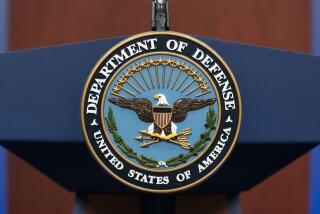Reserves Call-Up Decision Delayed : Military: Officials acknowledge that part of the reason is to prepare the public for the impact.
- Share via
KENNEBUNKPORT, Me. — With the military pressing to call up reserves to support its massive Middle East deployment, Bush Administration officials said Tuesday a final decision has been delayed so that the Pentagon can match its vacancies with available military specialists.
Officials acknowledged, however, that the delay also reflects a desire to prepare for the expected public impact of a deployment expected to eventually send tens of thousands of reservists to active duty in the Persian Gulf region as well as within the United States.
President Bush’s decision on the scope of the initial reserve call-up is expected to come as early as today.
The Pentagon, meanwhile, reported that the United States has moved the equivalent of a small Midwestern city to the Middle East in the last 19 days--complete with all of the necessary foodstuffs, vehicles and belongings.
Air Force Gen. H.T. Johnson, commander of the U.S. Transportation Command and Military Airlift Command, said the massive movement of military personnel and equipment in less than three weeks is the largest operation of its kind in U.S. history.
Even in the absence of a formal reserve call-up, he said, about 4,200 military reservists have volunteered to fly the 89 C-5s and 195 C-141s that are being used in the airlift. In addition, 17 commercial airliners and 21 civilian cargo planes have been pressed into service.
Despite the significant volunteer effort, Johnson said the President would have to mobilize military reserve units because most volunteers could not be away from their jobs in private industry for more than 45 days.
Administration officials acknowledged that yanking neighborhood doctors and grocery clerks from their communities and sending them to war can be a wrenching experience, not just for the individuals and their communities but for the nation as a whole.
As part-time reservists are called up to become full-time soldiers, small towns and big cities alike will come to grips with the human dimensions of the crisis and the impact it can have across the continent, they noted.
The postponement of the President’s final decision has provided a welcome breathing space to allow the nation to become accustomed to the idea that the escalating crisis in the Middle East will involve a certain amount of personal disruption.
Bush’s assistants have said the President was nearly certain as of last Friday that he would call up reserve units. Officials said the paper work to activate the reserves lacks only a presidential signature.
But they said the Administration decided to delay the final step while complex preparations are still under way. The goal was to try to avoid confusion and minimize further delays once the decision is announced.
“There’s just a lot of detail,” one senior White House official said. “When it is signed, all these people are going to be told what is expected of them. You want them to be able to get a definite word one way or the other. You’re dealing with people’s lives and their employment.”
Defense Secretary Dick Cheney and Gen. Colin L. Powell, chairman of the Joint Chiefs of Staff, are set to meet with Bush today in Kennebunkport, Me. Among other things, they are expected to discuss the reserve call-up, White House Press Secretary Marlin Fitzwater said.
White House Chief of Staff John H. Sununu said the White House wants to make sure that the activation order is able to match the right military personnel with the vacancies that need to be filled.
Officials have said that as many as 150,000 reservists eventually could be called into active duty. Many would represent specialties, such as medicine and cargo handling, that are in short supply among active-duty forces.
At the Pentagon, Gen. Johnson told a news briefing that the military, with help from reserve volunteers and the private sector, has transported the equivalent of Fayette, Ind., population 27,500, or Jefferson City, Mo., population 36,000, to the Persian Gulf.
“We’re fortunate we didn’t have to fight our way in,” Johnson said. “We’ve had no major surprises.”
He said the airlift initially strained the military’s capacity as the United States hurried combat units to the Persian Gulf after Iraq’s Aug. 2 invasion of Kuwait. But in recent days the operation has relied more on ship, which have spare capacity, Johnson said.
Most tanks and military vehicles have been rushed overseas aboard eight “fast sealift” ships capable of speeds up to 33 knots. The operation also involved unloading 12 Navy vessels pre-positioned in the Indian Ocean and stocked with ammunition, fuel, food and medical supplies.
The Pentagon also has activated 38 ships from its “ready reserve fleet” and chartered 8 ships from commercial lines, Johnson said.
The 1 billion pounds of material transported or still en route to the region is equal to all the cars, trucks, foodstuff, stocks, household goods and water supply of a small city, he told reporters.
Johnson declined to divulge the specific number of troops or military vehicles that have been put into place in Saudi Arabia.
But he said 99% of all U.S. troops have been flown to the gulf in C-5 Galaxy and C-141 Starlifter transports. The trip takes 15 hours from the East Coast and about 20 hours from West Coast embarkation points.
Participation by commercial air carriers began last Friday when Johnson activated a program known as the Civil Reserve Air Fleet for the first time since its inception in 1951, at the time of the Korean war.
Gerstenzang reported from Kennebunkport and Jackson from Washington.
More to Read
Sign up for Essential California
The most important California stories and recommendations in your inbox every morning.
You may occasionally receive promotional content from the Los Angeles Times.













